Audit Test Report: Analysis of Lowland University Payroll System
VerifiedAdded on 2021/04/17
|10
|1978
|76
Report
AI Summary
This report presents an audit test conducted on the payroll system of Lowland University. It begins by identifying five key deficiencies within the system, including issues with wage computation, unauthorized data access, lack of overtime authorization, inefficient overtime reporting, and inadequate leave cover arrangements. The report then proposes specific controls to address each deficiency, such as recalculation of pay earnings, restricting data access, ensuring proper overtime authorization, improving overtime sheet processing, and enhancing communication with the payroll department. Furthermore, the report outlines the tests of control required to assess the effectiveness of these proposed controls. Finally, the report discusses the substantive procedures to be carried out during the final audit, including agreeing wages to ledger accounts, performing analytical procedures, comparing wages with budgets, and verifying outstanding tax payables. The use of audit software and test data is also highlighted as essential tools for a successful final audit of wages and salaries.
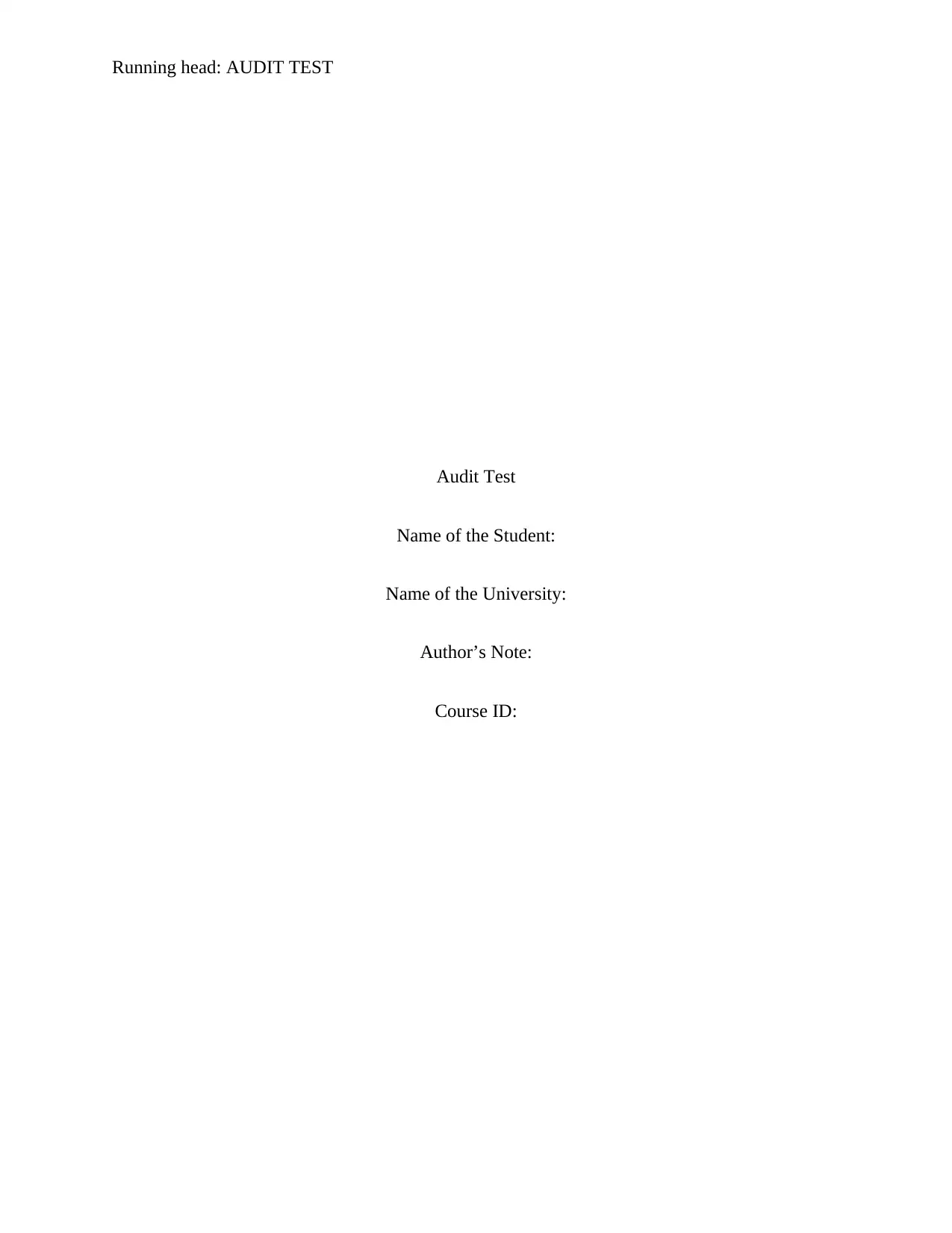
Running head: AUDIT TEST
Audit Test
Name of the Student:
Name of the University:
Author’s Note:
Course ID:
Audit Test
Name of the Student:
Name of the University:
Author’s Note:
Course ID:
Paraphrase This Document
Need a fresh take? Get an instant paraphrase of this document with our AI Paraphraser
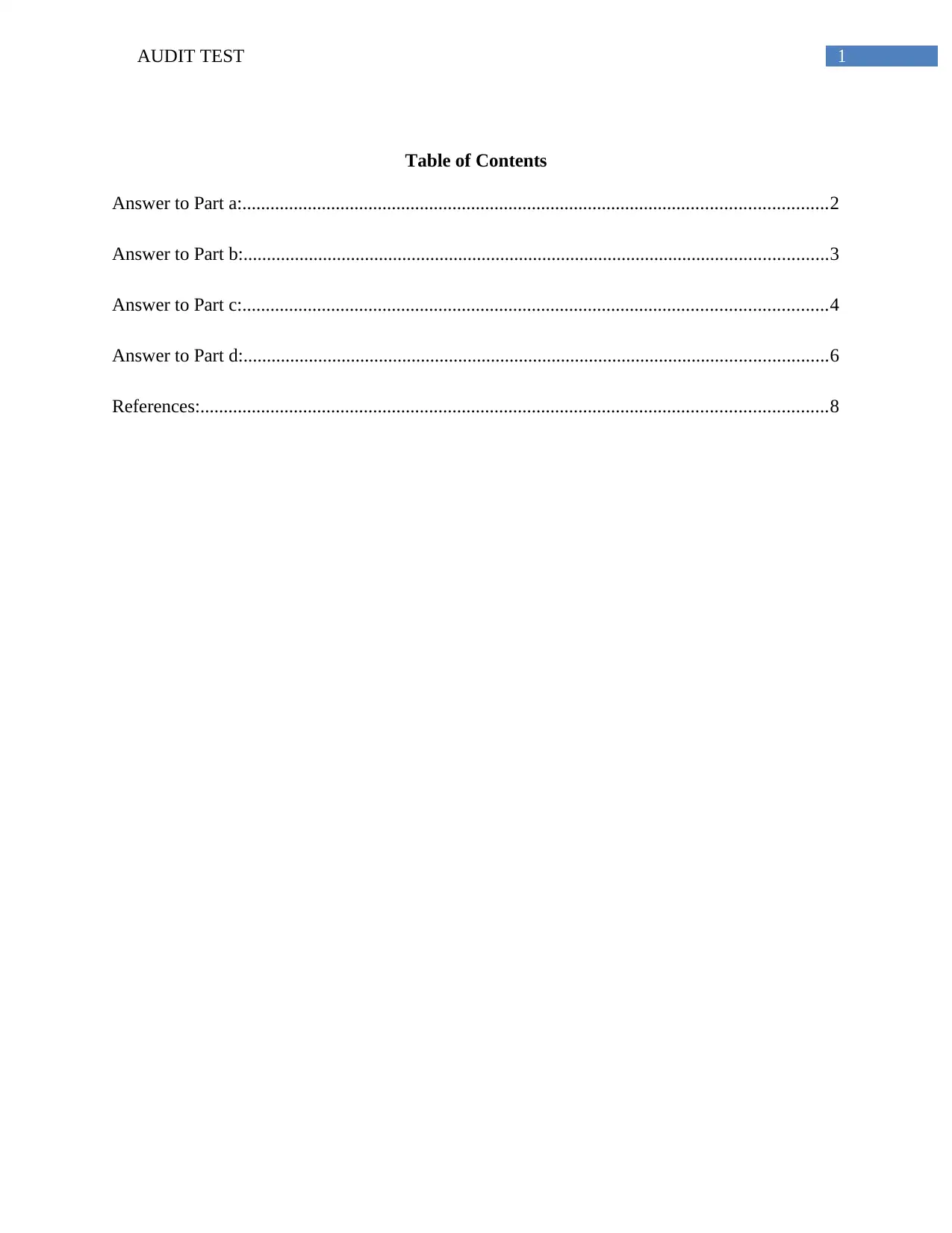
1AUDIT TEST
Table of Contents
Answer to Part a:.............................................................................................................................2
Answer to Part b:.............................................................................................................................3
Answer to Part c:.............................................................................................................................4
Answer to Part d:.............................................................................................................................6
References:......................................................................................................................................8
Table of Contents
Answer to Part a:.............................................................................................................................2
Answer to Part b:.............................................................................................................................3
Answer to Part c:.............................................................................................................................4
Answer to Part d:.............................................................................................................................6
References:......................................................................................................................................8
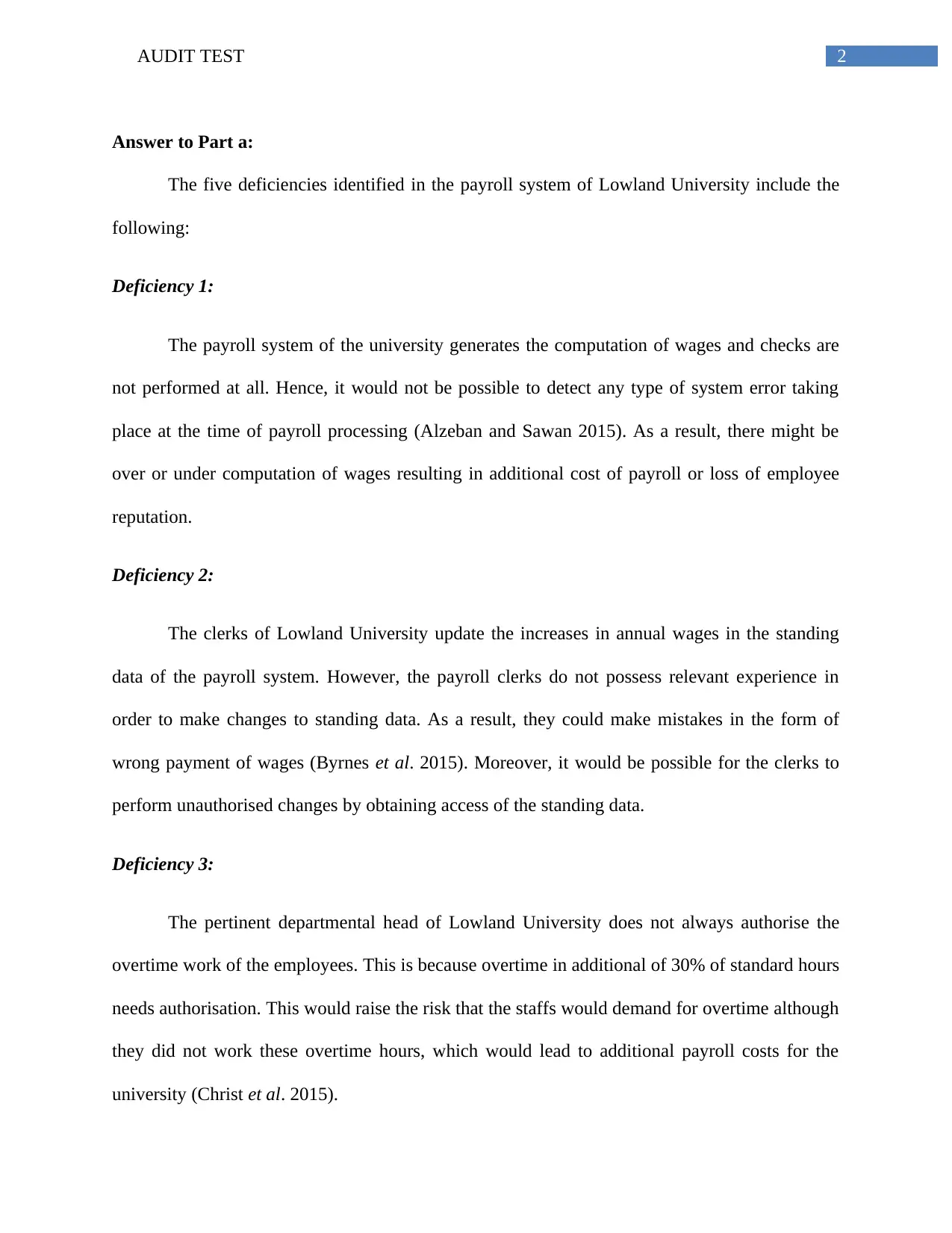
2AUDIT TEST
Answer to Part a:
The five deficiencies identified in the payroll system of Lowland University include the
following:
Deficiency 1:
The payroll system of the university generates the computation of wages and checks are
not performed at all. Hence, it would not be possible to detect any type of system error taking
place at the time of payroll processing (Alzeban and Sawan 2015). As a result, there might be
over or under computation of wages resulting in additional cost of payroll or loss of employee
reputation.
Deficiency 2:
The clerks of Lowland University update the increases in annual wages in the standing
data of the payroll system. However, the payroll clerks do not possess relevant experience in
order to make changes to standing data. As a result, they could make mistakes in the form of
wrong payment of wages (Byrnes et al. 2015). Moreover, it would be possible for the clerks to
perform unauthorised changes by obtaining access of the standing data.
Deficiency 3:
The pertinent departmental head of Lowland University does not always authorise the
overtime work of the employees. This is because overtime in additional of 30% of standard hours
needs authorisation. This would raise the risk that the staffs would demand for overtime although
they did not work these overtime hours, which would lead to additional payroll costs for the
university (Christ et al. 2015).
Answer to Part a:
The five deficiencies identified in the payroll system of Lowland University include the
following:
Deficiency 1:
The payroll system of the university generates the computation of wages and checks are
not performed at all. Hence, it would not be possible to detect any type of system error taking
place at the time of payroll processing (Alzeban and Sawan 2015). As a result, there might be
over or under computation of wages resulting in additional cost of payroll or loss of employee
reputation.
Deficiency 2:
The clerks of Lowland University update the increases in annual wages in the standing
data of the payroll system. However, the payroll clerks do not possess relevant experience in
order to make changes to standing data. As a result, they could make mistakes in the form of
wrong payment of wages (Byrnes et al. 2015). Moreover, it would be possible for the clerks to
perform unauthorised changes by obtaining access of the standing data.
Deficiency 3:
The pertinent departmental head of Lowland University does not always authorise the
overtime work of the employees. This is because overtime in additional of 30% of standard hours
needs authorisation. This would raise the risk that the staffs would demand for overtime although
they did not work these overtime hours, which would lead to additional payroll costs for the
university (Christ et al. 2015).
⊘ This is a preview!⊘
Do you want full access?
Subscribe today to unlock all pages.

Trusted by 1+ million students worldwide
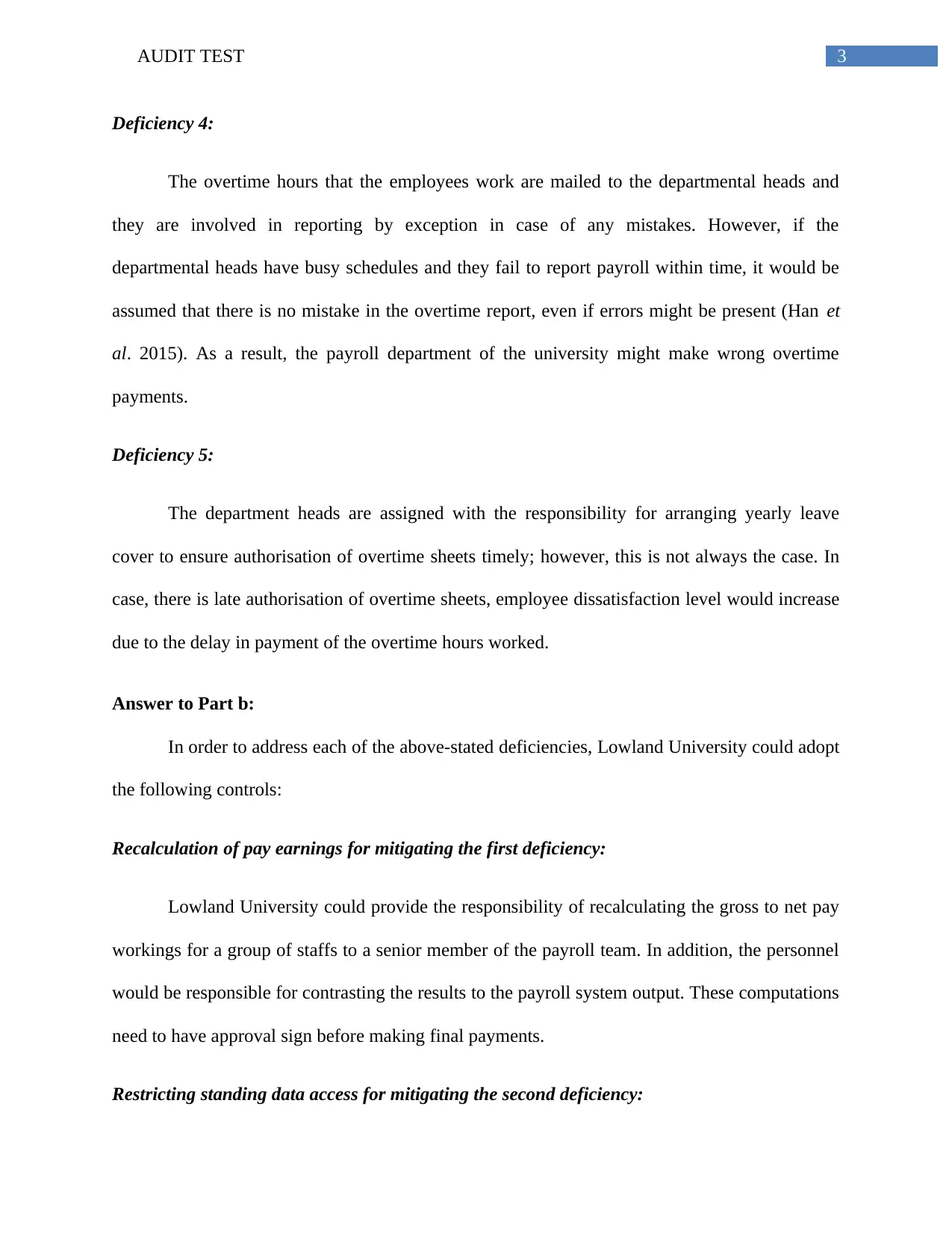
3AUDIT TEST
Deficiency 4:
The overtime hours that the employees work are mailed to the departmental heads and
they are involved in reporting by exception in case of any mistakes. However, if the
departmental heads have busy schedules and they fail to report payroll within time, it would be
assumed that there is no mistake in the overtime report, even if errors might be present (Han et
al. 2015). As a result, the payroll department of the university might make wrong overtime
payments.
Deficiency 5:
The department heads are assigned with the responsibility for arranging yearly leave
cover to ensure authorisation of overtime sheets timely; however, this is not always the case. In
case, there is late authorisation of overtime sheets, employee dissatisfaction level would increase
due to the delay in payment of the overtime hours worked.
Answer to Part b:
In order to address each of the above-stated deficiencies, Lowland University could adopt
the following controls:
Recalculation of pay earnings for mitigating the first deficiency:
Lowland University could provide the responsibility of recalculating the gross to net pay
workings for a group of staffs to a senior member of the payroll team. In addition, the personnel
would be responsible for contrasting the results to the payroll system output. These computations
need to have approval sign before making final payments.
Restricting standing data access for mitigating the second deficiency:
Deficiency 4:
The overtime hours that the employees work are mailed to the departmental heads and
they are involved in reporting by exception in case of any mistakes. However, if the
departmental heads have busy schedules and they fail to report payroll within time, it would be
assumed that there is no mistake in the overtime report, even if errors might be present (Han et
al. 2015). As a result, the payroll department of the university might make wrong overtime
payments.
Deficiency 5:
The department heads are assigned with the responsibility for arranging yearly leave
cover to ensure authorisation of overtime sheets timely; however, this is not always the case. In
case, there is late authorisation of overtime sheets, employee dissatisfaction level would increase
due to the delay in payment of the overtime hours worked.
Answer to Part b:
In order to address each of the above-stated deficiencies, Lowland University could adopt
the following controls:
Recalculation of pay earnings for mitigating the first deficiency:
Lowland University could provide the responsibility of recalculating the gross to net pay
workings for a group of staffs to a senior member of the payroll team. In addition, the personnel
would be responsible for contrasting the results to the payroll system output. These computations
need to have approval sign before making final payments.
Restricting standing data access for mitigating the second deficiency:
Paraphrase This Document
Need a fresh take? Get an instant paraphrase of this document with our AI Paraphraser
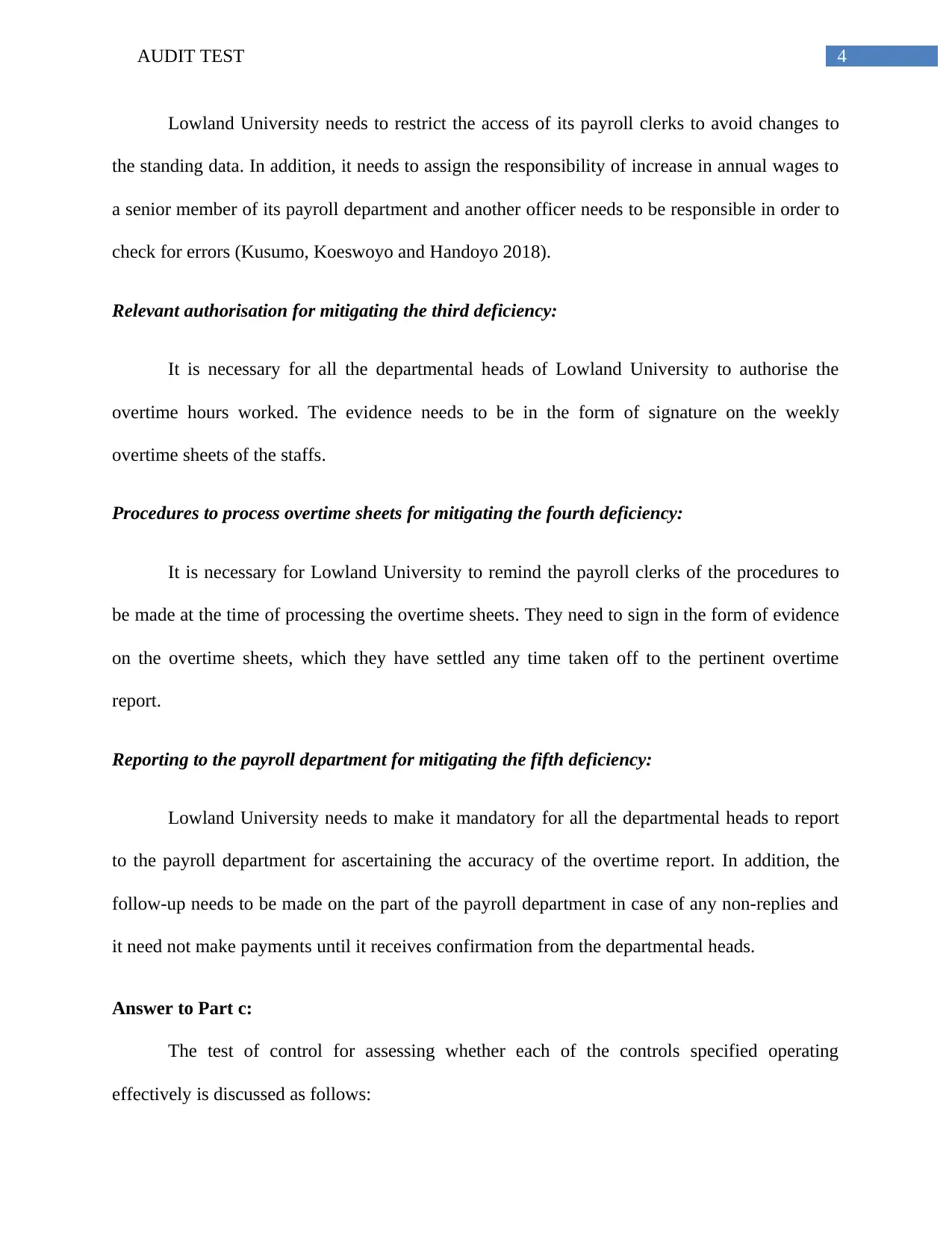
4AUDIT TEST
Lowland University needs to restrict the access of its payroll clerks to avoid changes to
the standing data. In addition, it needs to assign the responsibility of increase in annual wages to
a senior member of its payroll department and another officer needs to be responsible in order to
check for errors (Kusumo, Koeswoyo and Handoyo 2018).
Relevant authorisation for mitigating the third deficiency:
It is necessary for all the departmental heads of Lowland University to authorise the
overtime hours worked. The evidence needs to be in the form of signature on the weekly
overtime sheets of the staffs.
Procedures to process overtime sheets for mitigating the fourth deficiency:
It is necessary for Lowland University to remind the payroll clerks of the procedures to
be made at the time of processing the overtime sheets. They need to sign in the form of evidence
on the overtime sheets, which they have settled any time taken off to the pertinent overtime
report.
Reporting to the payroll department for mitigating the fifth deficiency:
Lowland University needs to make it mandatory for all the departmental heads to report
to the payroll department for ascertaining the accuracy of the overtime report. In addition, the
follow-up needs to be made on the part of the payroll department in case of any non-replies and
it need not make payments until it receives confirmation from the departmental heads.
Answer to Part c:
The test of control for assessing whether each of the controls specified operating
effectively is discussed as follows:
Lowland University needs to restrict the access of its payroll clerks to avoid changes to
the standing data. In addition, it needs to assign the responsibility of increase in annual wages to
a senior member of its payroll department and another officer needs to be responsible in order to
check for errors (Kusumo, Koeswoyo and Handoyo 2018).
Relevant authorisation for mitigating the third deficiency:
It is necessary for all the departmental heads of Lowland University to authorise the
overtime hours worked. The evidence needs to be in the form of signature on the weekly
overtime sheets of the staffs.
Procedures to process overtime sheets for mitigating the fourth deficiency:
It is necessary for Lowland University to remind the payroll clerks of the procedures to
be made at the time of processing the overtime sheets. They need to sign in the form of evidence
on the overtime sheets, which they have settled any time taken off to the pertinent overtime
report.
Reporting to the payroll department for mitigating the fifth deficiency:
Lowland University needs to make it mandatory for all the departmental heads to report
to the payroll department for ascertaining the accuracy of the overtime report. In addition, the
follow-up needs to be made on the part of the payroll department in case of any non-replies and
it need not make payments until it receives confirmation from the departmental heads.
Answer to Part c:
The test of control for assessing whether each of the controls specified operating
effectively is discussed as follows:
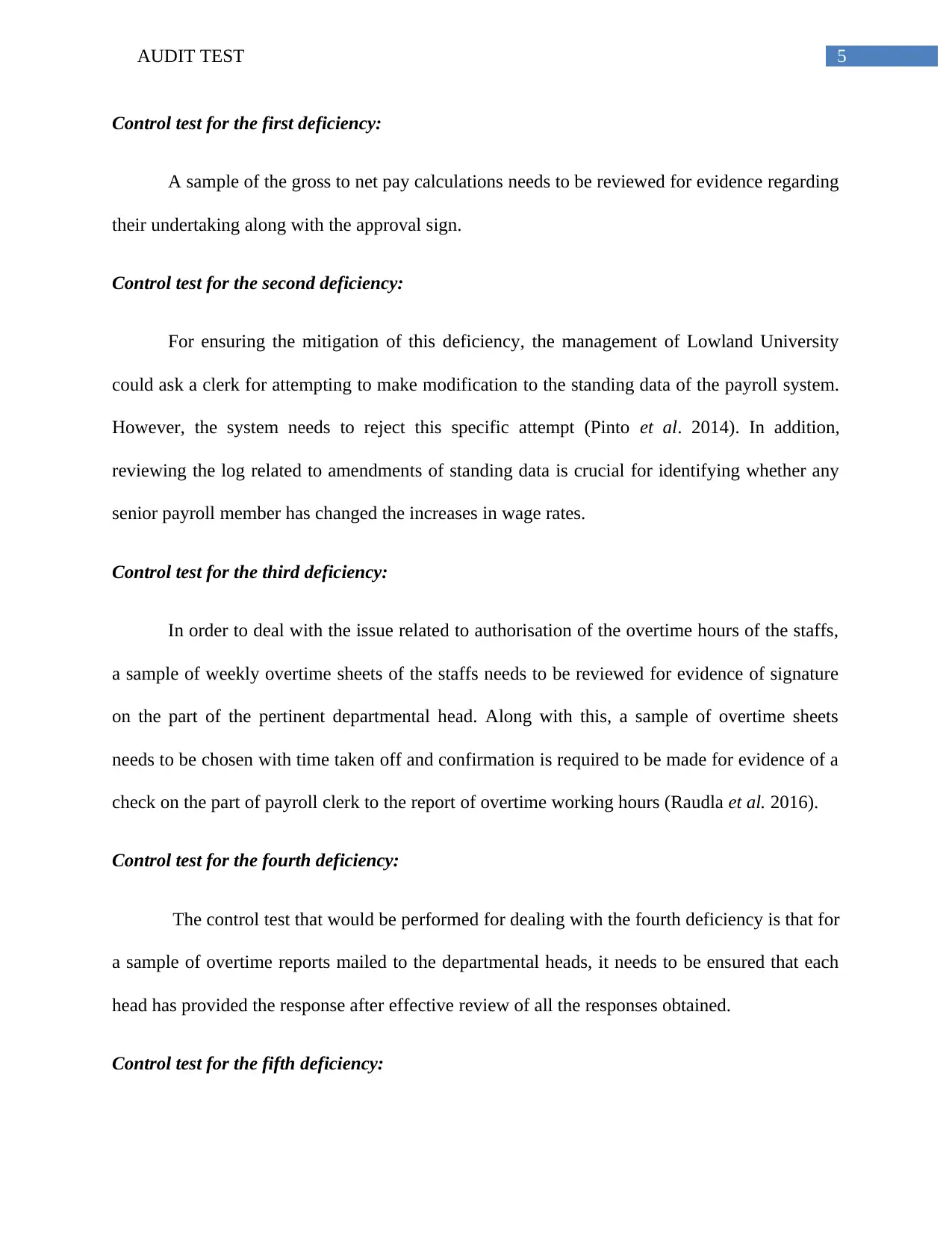
5AUDIT TEST
Control test for the first deficiency:
A sample of the gross to net pay calculations needs to be reviewed for evidence regarding
their undertaking along with the approval sign.
Control test for the second deficiency:
For ensuring the mitigation of this deficiency, the management of Lowland University
could ask a clerk for attempting to make modification to the standing data of the payroll system.
However, the system needs to reject this specific attempt (Pinto et al. 2014). In addition,
reviewing the log related to amendments of standing data is crucial for identifying whether any
senior payroll member has changed the increases in wage rates.
Control test for the third deficiency:
In order to deal with the issue related to authorisation of the overtime hours of the staffs,
a sample of weekly overtime sheets of the staffs needs to be reviewed for evidence of signature
on the part of the pertinent departmental head. Along with this, a sample of overtime sheets
needs to be chosen with time taken off and confirmation is required to be made for evidence of a
check on the part of payroll clerk to the report of overtime working hours (Raudla et al. 2016).
Control test for the fourth deficiency:
The control test that would be performed for dealing with the fourth deficiency is that for
a sample of overtime reports mailed to the departmental heads, it needs to be ensured that each
head has provided the response after effective review of all the responses obtained.
Control test for the fifth deficiency:
Control test for the first deficiency:
A sample of the gross to net pay calculations needs to be reviewed for evidence regarding
their undertaking along with the approval sign.
Control test for the second deficiency:
For ensuring the mitigation of this deficiency, the management of Lowland University
could ask a clerk for attempting to make modification to the standing data of the payroll system.
However, the system needs to reject this specific attempt (Pinto et al. 2014). In addition,
reviewing the log related to amendments of standing data is crucial for identifying whether any
senior payroll member has changed the increases in wage rates.
Control test for the third deficiency:
In order to deal with the issue related to authorisation of the overtime hours of the staffs,
a sample of weekly overtime sheets of the staffs needs to be reviewed for evidence of signature
on the part of the pertinent departmental head. Along with this, a sample of overtime sheets
needs to be chosen with time taken off and confirmation is required to be made for evidence of a
check on the part of payroll clerk to the report of overtime working hours (Raudla et al. 2016).
Control test for the fourth deficiency:
The control test that would be performed for dealing with the fourth deficiency is that for
a sample of overtime reports mailed to the departmental heads, it needs to be ensured that each
head has provided the response after effective review of all the responses obtained.
Control test for the fifth deficiency:
⊘ This is a preview!⊘
Do you want full access?
Subscribe today to unlock all pages.

Trusted by 1+ million students worldwide
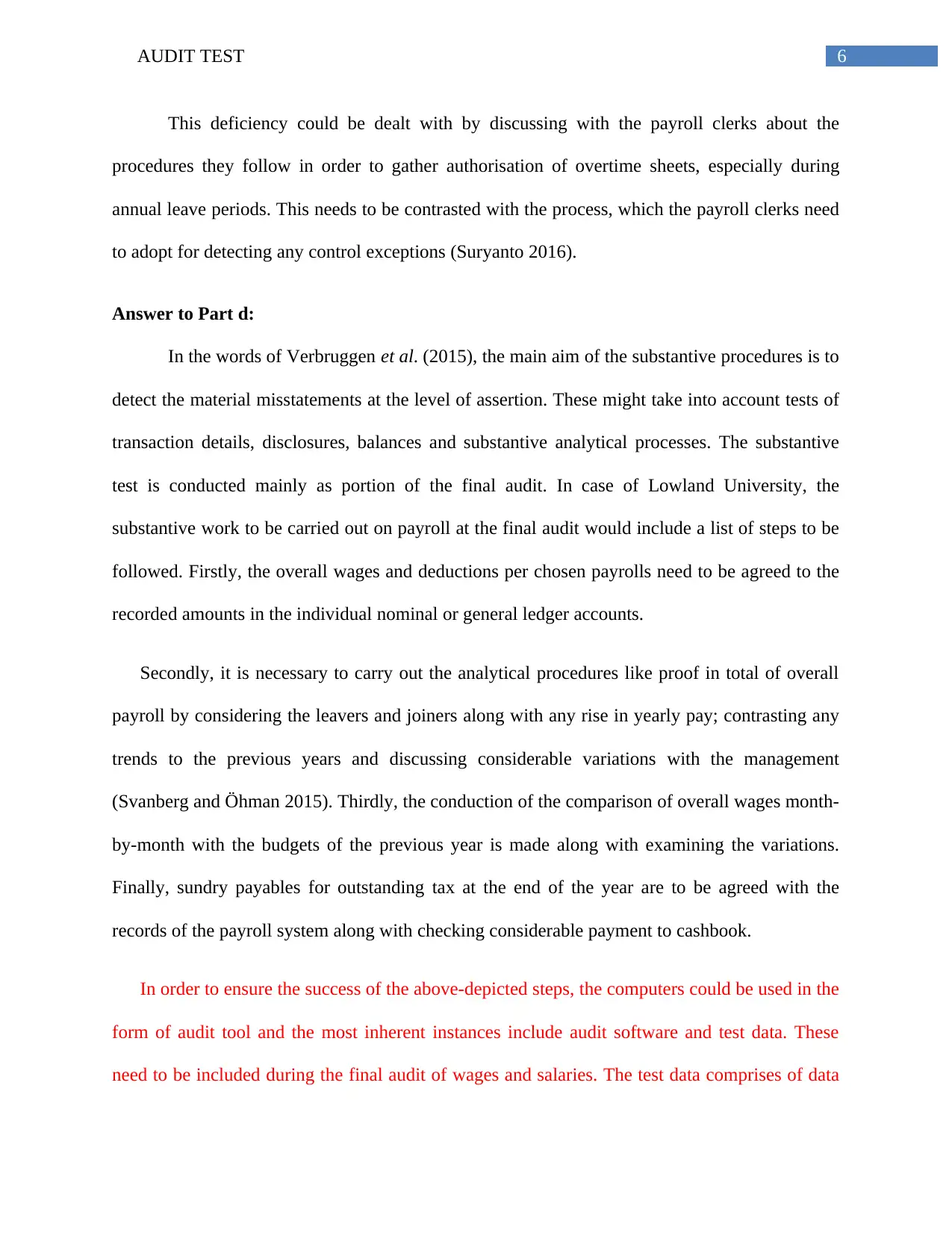
6AUDIT TEST
This deficiency could be dealt with by discussing with the payroll clerks about the
procedures they follow in order to gather authorisation of overtime sheets, especially during
annual leave periods. This needs to be contrasted with the process, which the payroll clerks need
to adopt for detecting any control exceptions (Suryanto 2016).
Answer to Part d:
In the words of Verbruggen et al. (2015), the main aim of the substantive procedures is to
detect the material misstatements at the level of assertion. These might take into account tests of
transaction details, disclosures, balances and substantive analytical processes. The substantive
test is conducted mainly as portion of the final audit. In case of Lowland University, the
substantive work to be carried out on payroll at the final audit would include a list of steps to be
followed. Firstly, the overall wages and deductions per chosen payrolls need to be agreed to the
recorded amounts in the individual nominal or general ledger accounts.
Secondly, it is necessary to carry out the analytical procedures like proof in total of overall
payroll by considering the leavers and joiners along with any rise in yearly pay; contrasting any
trends to the previous years and discussing considerable variations with the management
(Svanberg and Öhman 2015). Thirdly, the conduction of the comparison of overall wages month-
by-month with the budgets of the previous year is made along with examining the variations.
Finally, sundry payables for outstanding tax at the end of the year are to be agreed with the
records of the payroll system along with checking considerable payment to cashbook.
In order to ensure the success of the above-depicted steps, the computers could be used in the
form of audit tool and the most inherent instances include audit software and test data. These
need to be included during the final audit of wages and salaries. The test data comprises of data
This deficiency could be dealt with by discussing with the payroll clerks about the
procedures they follow in order to gather authorisation of overtime sheets, especially during
annual leave periods. This needs to be contrasted with the process, which the payroll clerks need
to adopt for detecting any control exceptions (Suryanto 2016).
Answer to Part d:
In the words of Verbruggen et al. (2015), the main aim of the substantive procedures is to
detect the material misstatements at the level of assertion. These might take into account tests of
transaction details, disclosures, balances and substantive analytical processes. The substantive
test is conducted mainly as portion of the final audit. In case of Lowland University, the
substantive work to be carried out on payroll at the final audit would include a list of steps to be
followed. Firstly, the overall wages and deductions per chosen payrolls need to be agreed to the
recorded amounts in the individual nominal or general ledger accounts.
Secondly, it is necessary to carry out the analytical procedures like proof in total of overall
payroll by considering the leavers and joiners along with any rise in yearly pay; contrasting any
trends to the previous years and discussing considerable variations with the management
(Svanberg and Öhman 2015). Thirdly, the conduction of the comparison of overall wages month-
by-month with the budgets of the previous year is made along with examining the variations.
Finally, sundry payables for outstanding tax at the end of the year are to be agreed with the
records of the payroll system along with checking considerable payment to cashbook.
In order to ensure the success of the above-depicted steps, the computers could be used in the
form of audit tool and the most inherent instances include audit software and test data. These
need to be included during the final audit of wages and salaries. The test data comprises of data
Paraphrase This Document
Need a fresh take? Get an instant paraphrase of this document with our AI Paraphraser
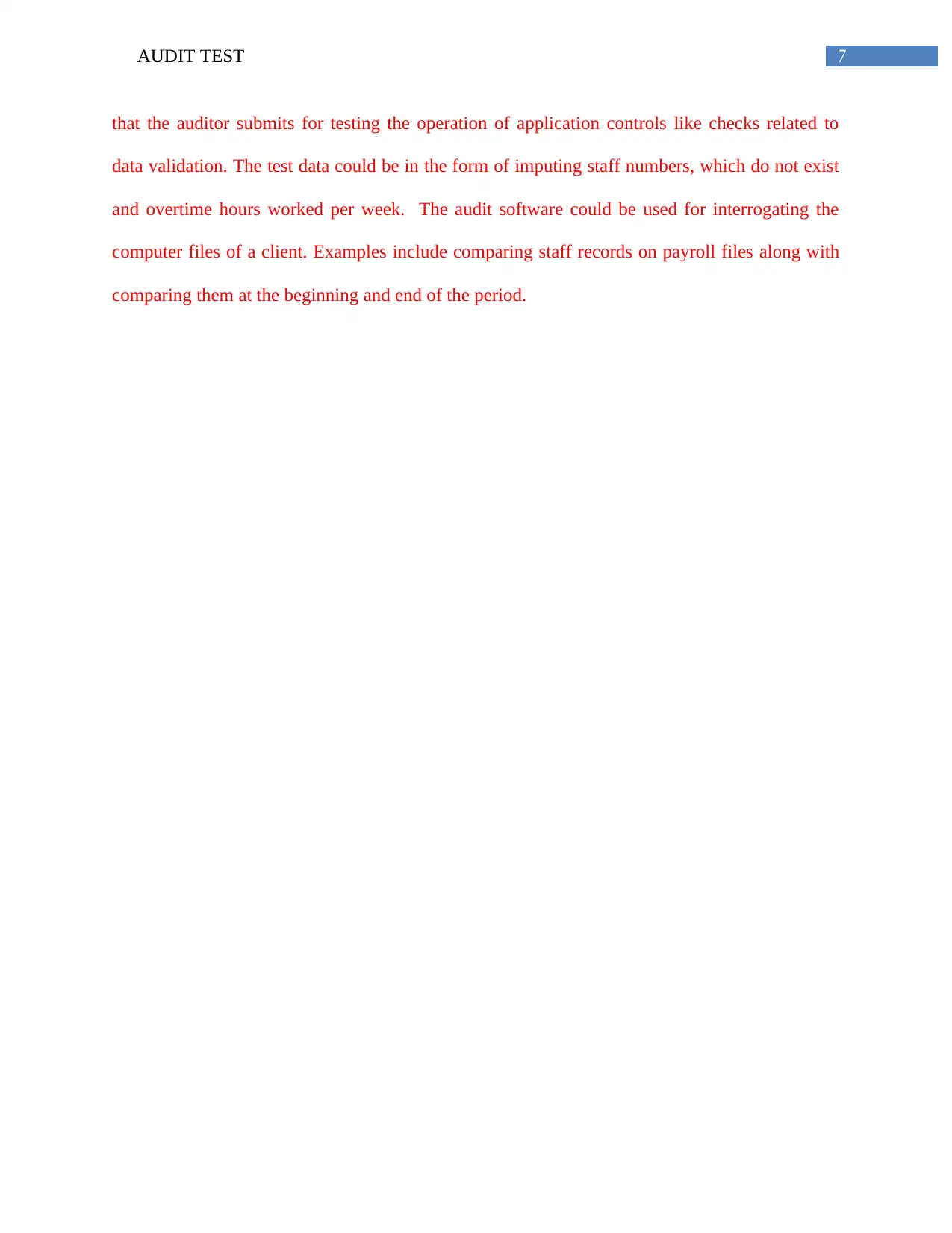
7AUDIT TEST
that the auditor submits for testing the operation of application controls like checks related to
data validation. The test data could be in the form of imputing staff numbers, which do not exist
and overtime hours worked per week. The audit software could be used for interrogating the
computer files of a client. Examples include comparing staff records on payroll files along with
comparing them at the beginning and end of the period.
that the auditor submits for testing the operation of application controls like checks related to
data validation. The test data could be in the form of imputing staff numbers, which do not exist
and overtime hours worked per week. The audit software could be used for interrogating the
computer files of a client. Examples include comparing staff records on payroll files along with
comparing them at the beginning and end of the period.
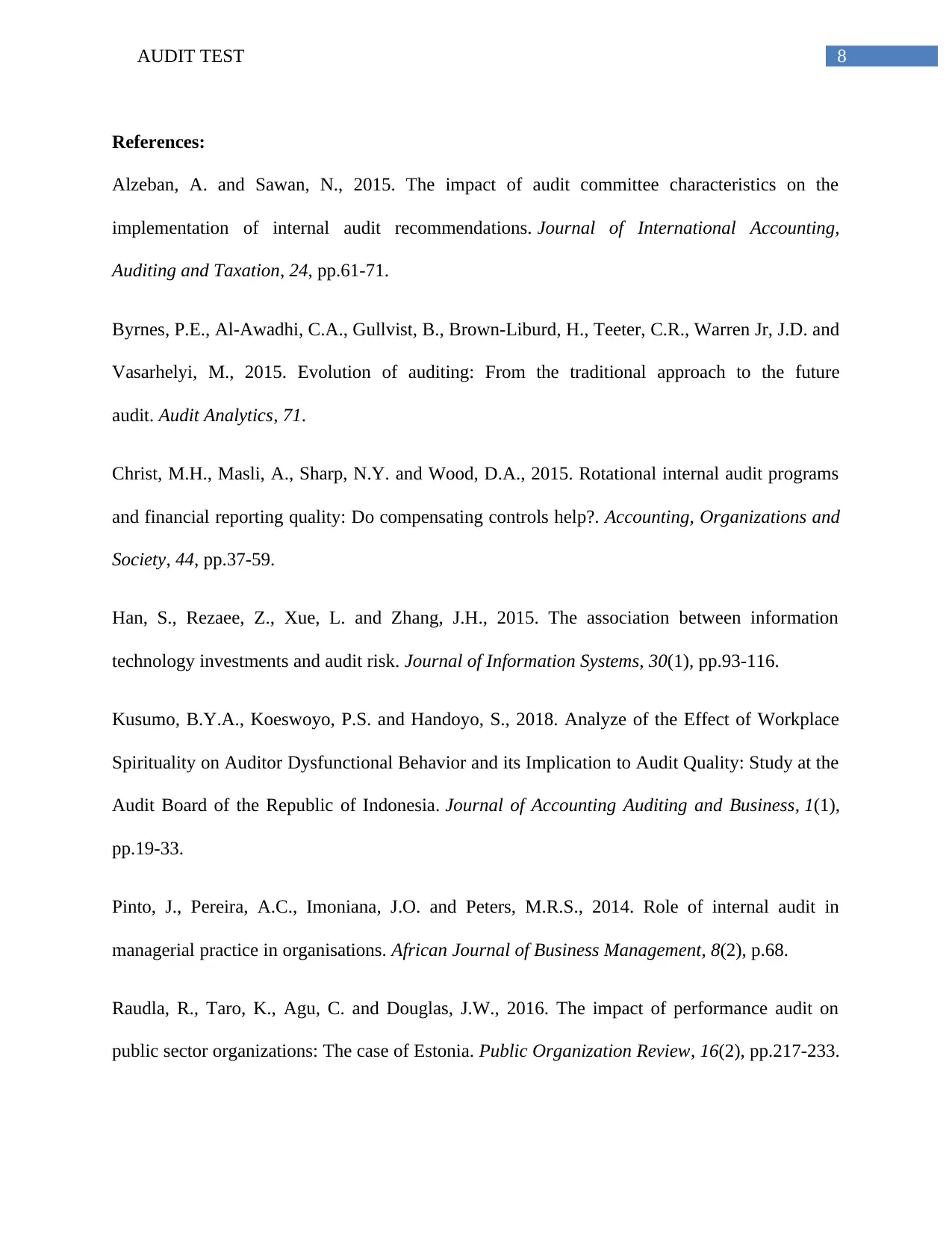
8AUDIT TEST
References:
Alzeban, A. and Sawan, N., 2015. The impact of audit committee characteristics on the
implementation of internal audit recommendations. Journal of International Accounting,
Auditing and Taxation, 24, pp.61-71.
Byrnes, P.E., Al-Awadhi, C.A., Gullvist, B., Brown-Liburd, H., Teeter, C.R., Warren Jr, J.D. and
Vasarhelyi, M., 2015. Evolution of auditing: From the traditional approach to the future
audit. Audit Analytics, 71.
Christ, M.H., Masli, A., Sharp, N.Y. and Wood, D.A., 2015. Rotational internal audit programs
and financial reporting quality: Do compensating controls help?. Accounting, Organizations and
Society, 44, pp.37-59.
Han, S., Rezaee, Z., Xue, L. and Zhang, J.H., 2015. The association between information
technology investments and audit risk. Journal of Information Systems, 30(1), pp.93-116.
Kusumo, B.Y.A., Koeswoyo, P.S. and Handoyo, S., 2018. Analyze of the Effect of Workplace
Spirituality on Auditor Dysfunctional Behavior and its Implication to Audit Quality: Study at the
Audit Board of the Republic of Indonesia. Journal of Accounting Auditing and Business, 1(1),
pp.19-33.
Pinto, J., Pereira, A.C., Imoniana, J.O. and Peters, M.R.S., 2014. Role of internal audit in
managerial practice in organisations. African Journal of Business Management, 8(2), p.68.
Raudla, R., Taro, K., Agu, C. and Douglas, J.W., 2016. The impact of performance audit on
public sector organizations: The case of Estonia. Public Organization Review, 16(2), pp.217-233.
References:
Alzeban, A. and Sawan, N., 2015. The impact of audit committee characteristics on the
implementation of internal audit recommendations. Journal of International Accounting,
Auditing and Taxation, 24, pp.61-71.
Byrnes, P.E., Al-Awadhi, C.A., Gullvist, B., Brown-Liburd, H., Teeter, C.R., Warren Jr, J.D. and
Vasarhelyi, M., 2015. Evolution of auditing: From the traditional approach to the future
audit. Audit Analytics, 71.
Christ, M.H., Masli, A., Sharp, N.Y. and Wood, D.A., 2015. Rotational internal audit programs
and financial reporting quality: Do compensating controls help?. Accounting, Organizations and
Society, 44, pp.37-59.
Han, S., Rezaee, Z., Xue, L. and Zhang, J.H., 2015. The association between information
technology investments and audit risk. Journal of Information Systems, 30(1), pp.93-116.
Kusumo, B.Y.A., Koeswoyo, P.S. and Handoyo, S., 2018. Analyze of the Effect of Workplace
Spirituality on Auditor Dysfunctional Behavior and its Implication to Audit Quality: Study at the
Audit Board of the Republic of Indonesia. Journal of Accounting Auditing and Business, 1(1),
pp.19-33.
Pinto, J., Pereira, A.C., Imoniana, J.O. and Peters, M.R.S., 2014. Role of internal audit in
managerial practice in organisations. African Journal of Business Management, 8(2), p.68.
Raudla, R., Taro, K., Agu, C. and Douglas, J.W., 2016. The impact of performance audit on
public sector organizations: The case of Estonia. Public Organization Review, 16(2), pp.217-233.
⊘ This is a preview!⊘
Do you want full access?
Subscribe today to unlock all pages.

Trusted by 1+ million students worldwide
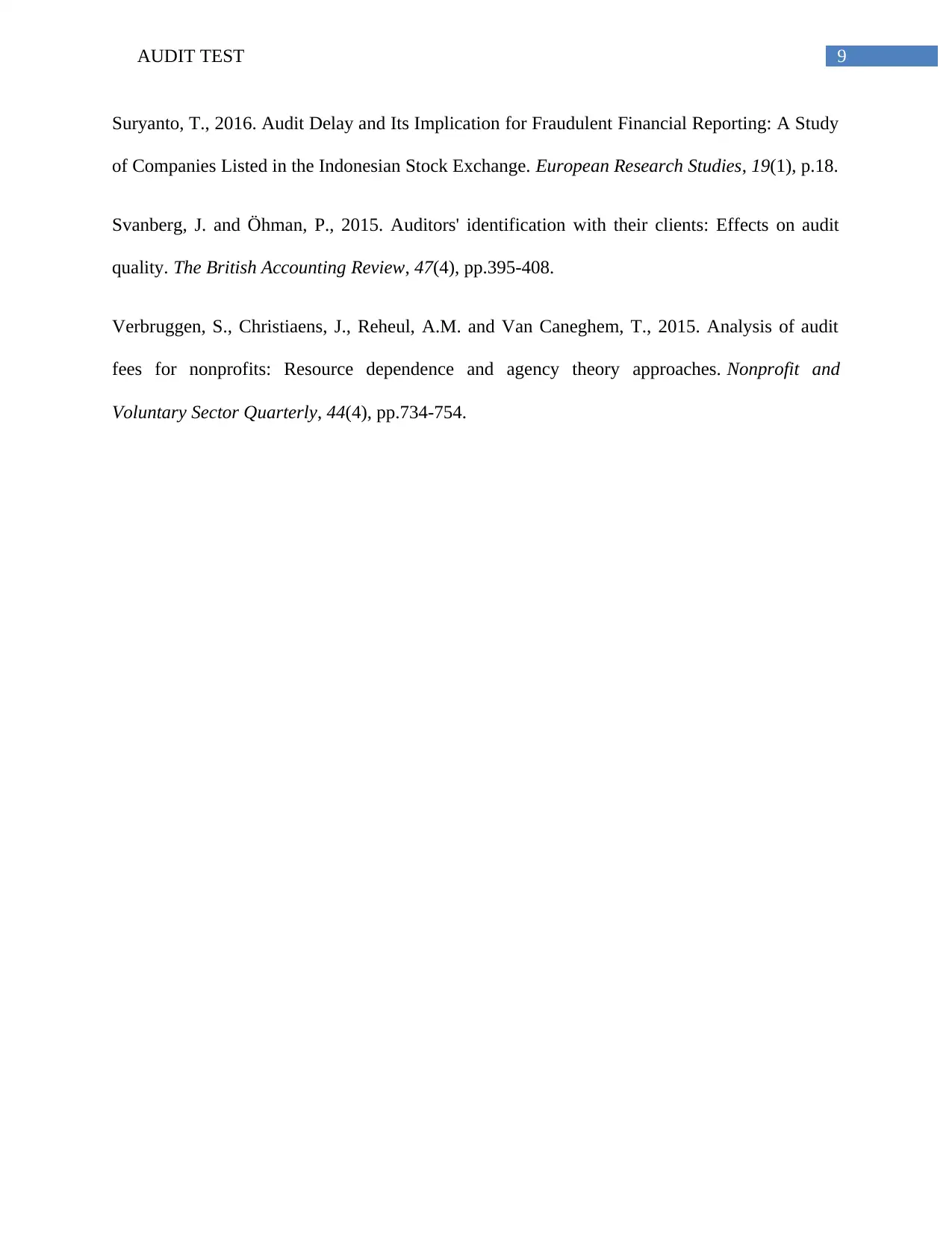
9AUDIT TEST
Suryanto, T., 2016. Audit Delay and Its Implication for Fraudulent Financial Reporting: A Study
of Companies Listed in the Indonesian Stock Exchange. European Research Studies, 19(1), p.18.
Svanberg, J. and Öhman, P., 2015. Auditors' identification with their clients: Effects on audit
quality. The British Accounting Review, 47(4), pp.395-408.
Verbruggen, S., Christiaens, J., Reheul, A.M. and Van Caneghem, T., 2015. Analysis of audit
fees for nonprofits: Resource dependence and agency theory approaches. Nonprofit and
Voluntary Sector Quarterly, 44(4), pp.734-754.
Suryanto, T., 2016. Audit Delay and Its Implication for Fraudulent Financial Reporting: A Study
of Companies Listed in the Indonesian Stock Exchange. European Research Studies, 19(1), p.18.
Svanberg, J. and Öhman, P., 2015. Auditors' identification with their clients: Effects on audit
quality. The British Accounting Review, 47(4), pp.395-408.
Verbruggen, S., Christiaens, J., Reheul, A.M. and Van Caneghem, T., 2015. Analysis of audit
fees for nonprofits: Resource dependence and agency theory approaches. Nonprofit and
Voluntary Sector Quarterly, 44(4), pp.734-754.
1 out of 10
Your All-in-One AI-Powered Toolkit for Academic Success.
+13062052269
info@desklib.com
Available 24*7 on WhatsApp / Email
![[object Object]](/_next/static/media/star-bottom.7253800d.svg)
Unlock your academic potential
Copyright © 2020–2025 A2Z Services. All Rights Reserved. Developed and managed by ZUCOL.


